

Why the internet will never replace universities. As Education Secretary David Willetts has recognised , it also has a vital role to play in growing UK higher education’s share of the global student market. In a speech earlier this year, he urged UK universities to take advantage of an “historic opportunity” to meet soaring international demand. Online learning also offers a more affordable option for those for whom a full-price bricks and mortar university degree is simply unattainable. But again, this not about replacing one model with the other.
There will always be those who will want, and benefit from, the physical experience of attending a university. Moving forward, what’s important is to provide the right, quality provision in the right way for individuals. Effectively evaluating online learning programs. Effectively evaluating online learning programs starts with two simple ideas: Apply tried-and-true approaches, and take advantage of the opportunity to use new ones.
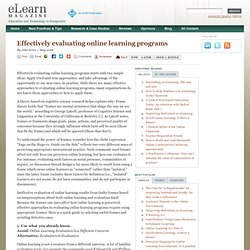
In practice, while there are many effective approaches to evaluating online learning programs, many organizations do not know these approaches or how to apply them. A theory based on cognitive science research helps explains why. Frame theory holds that "frames are mental structures that shape the way we see the world," according to George Lakoff, professor of Cognitive Science and Linguistics at the University of California at Berkeley [1]. As Lakoff notes, frames or framesets shape goals, plans, actions, and perceived quality of outcomes because they strongly influence which facts will be seen (those that fit the frame) and which will be ignored (those that don't). Predictors of Success for Adult Online Learners: A Review of the Literature. As an adjunct professor for an online-only graduate school course, I have found myself contemplating the retention rate of adult e-learners.
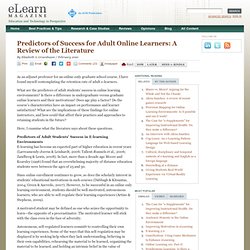
What are the predictors of adult students' success in online learning environments? Is there a difference in undergraduate versus graduate online learners and their motivations? Does age play a factor? Do the course's characteristics have an impact on performance and learner satisfaction? Must e-Learning Be 'Cool?' In 1989, when I was offered the opportunity to advise Andersen Consulting on how to do training and how to build what eventually came to be called e-learning, the first thing I encountered was role-playing.
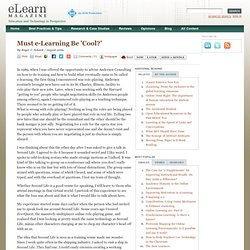
Andersen routinely brought new hires out to its St. Charles, Illinois, facility to role-play their new jobs. Later, when I was working with the Harvard "getting to yes" people who taught negotiation skills (to Andersen people among others), again I encountered role-playing as a teaching technique. There seemed to be no getting rid of it. What is wrong with role-playing? I was thinking about this the other day after I was asked to give a talk in Second Life. Whether Second Life is a good venue for speaking, I will leave to those who attend meetings in that virtual world.
My experience started some days earlier when the person who had invited me to speak took me around Second Life. The idea that Second Life is seen as a training venue made me wonder. But Second Life is cool. Comments. 3 Biggest Myths about Teaching Online Education. An investigation of distance education in North American research literature using co-word analysis. Implications of Online and Blended Learning for the Conceptual Development and Practice of Distance Education.
Beyond_multiple_choice.pdf. Rapid eLearning: Building a House Without an Architect. I was under the impression over the last couple years that the "rapid eLearning" wave had reached its crest and was fading, but after recently stumbling on some articles it seems that the concept still has its believers.

What's Rapid eLearning? Rapid eLearning is a label used by tool vendors to indicate their products will help customers develop and deliver eLearning content faster and cheaper by allowing subject matter experts (SMEs) to create eLearning without the intervention of eLearning professionals. For many of its advocates, rapid eLearning refers to the conversion of existing learning content such as slides from an existing classroom course into a Web-deliverable format, although content can also be developed from scratch using commonly used tools such as PowerPoint or Word.
What's Wrong With That? Although I recognize the merit of rapid eLearning tools, I must however disagree with the idea of developing eLearning without the intervention of learning professionals. Interorg-Task-Force-9-20-12.pdf (application/pdf Object) Collaborating Via Web Conference. Collaboration | Feature Collaborating Via Web Conference Advances in videoconferencing technology make it much easier for students and faculty to work together, regardless of where they are located.
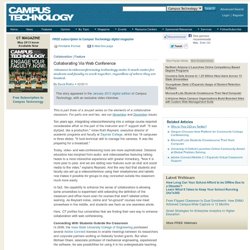
This is part three of a six-part series on the elements of a collaborative classroom. For parts one and two, see our November and December issues. Ten years ago, integrating videoconferencing into a college course required considerable effort on the part of the instructor and IT support staff. Today, video- and web-conferencing tools are more sophisticated. In fact, the capability to enhance the sense of collaboration is allowing some universities to experiment with extending the definition of the classroom and office hours even for courses that aren't labeled online learning.
Here, CT profiles four universities that are finding their own way to enhance collaboration with web conferencing. The-Right-to-Educational-Access.pdf (application/pdf Object) LINK-Conference_submission_final_draft 1.pdf (application/pdf Object) 5 E-Learning Trends for Higher Ed. Viewcontent.cgi (application/pdf Object)
At-risk online learners. At-risk adult learners—that is, learners who are not expected to succeed—are more likely to take online courses, but they're also more likely to drop out.
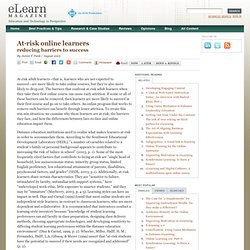
The barriers that confront at-risk adult learners when they take their first online course can cause early attrition. 7 Student Myths of the Online Classroom. Thanks to technology, students and instructors can share knowledge over large distances.
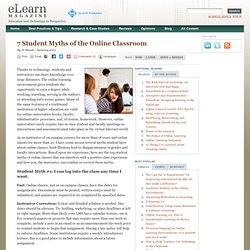
The online learning environment gives students the opportunity to earn a degree while working, traveling, serving in the military, or attending kid's soccer games. Rapid e-Learning Polarizes Opinion. Much to the disgruntlement of instructional designers and other e-learning specialists, rapid e-learning tools are offering in-house subject matter experts excellent opportunities to produce e-learning materials relatively quickly and cost-effectively—at least in the U.K. and U.S.
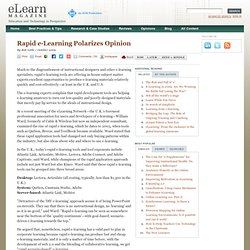
The e-learning experts complain that rapid development tools are helping e-learning amateurs to turn out low-quality and poorly-designed materials that merely pay lip service to the ideals of instructional design. At a recent meeting of the eLearning Network—the U.K.' Identifying e-Learning Technologists. Education has seen big changes, many of which have been technology-driven: the rise of online collaboration tools, the expanding role of e-learning, sophisticated learning-management systems, and new communication tools.
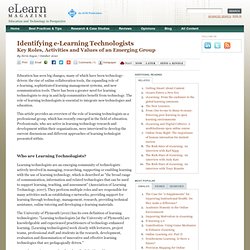
There has been a greater need for learning technologists to step in and help communities benefit from technology. The role of learning technologists is essential to integrate new technologies and education. This article provides an overview of the role of learning technologists as a professional group, which has recently emerged in the field of education. 02680513.2011.611684 (application/pdf Object) Procedia Computer Science - Deciding which technology is the best for distance education: Issues in media/technology comparisons studies. Volume 3 , 2011, Pages 1388–1395 World Conference on Information Technology.
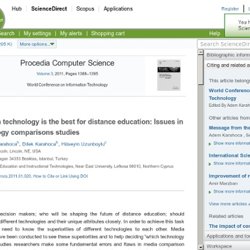
Teaching an Online Experience-based Leadership Course. Is it really possible to give online courses, with no physical meetings whatsoever, in leadership, where the students' learning to a large extent is based on experiences during the course in itself? Would it at the same time be possible to encourage critical thinking on a course like this, to create an online, experience-based, academic leadership course? I think it is, and I have tried to develop such a course.
It is my strongest belief that experiences have to be involved for good learning to happen—especially in a subject such as leadership. Survey: Most parents support mobile learning devices. A majority of parents overwhelmingly think that mobile apps, mobile content, and technology in the classroom promote positive learning habits and yield benefits, according to a new survey released on May 2.
“Living and Learning with Mobile Devices: What Parents Think About Mobile Devices for Early Childhood and K-12 Learning,” from Grunwald Associates, the Learning First Alliance, and underwritten by AT&T, surveyed 2,392 parents who have 4,164 children between the ages of 3-18. Most children in preschool through 12th grade have access to different technologies at home, and this includes mobile learning devices: Slightly more than half of all students (51 percent) carry a smart phone every day by the time they reach high school, 28 percent of middle school students bring a smart phone to school each day, and 8 percent of students in grades 3-5 do the same.
(Next page: How much technology are students using in the classroom?) Case methods for online learning. Case analysis is a popular teaching strategy in higher education, particularly in professional degree programs such as business, social work, education, medicine, law, and policy studies. This strategy allows students to apply ideas, theories, and concepts to realistic problem-solving situations. In a virtual classroom, the world is just a click away. Because the online learning environment and the online world of professional life overlap, instructors have new opportunities to engage students. This tutorial will examine how guiding students through the analysis of case studies can enhance online learning. A case study is a well-researched story with characters and drama. Today, professionals increasingly must collaborate to solve problems. How Government Policy Drives e-Learning.
Educators spend their lives neck deep in the tactics of education, but like most who labor on the front lines, they don't get to devise grand strategy. Instead, the education students receive at tomorrow's public schools, colleges, and universities is being shaped today by legislators and agencies that create public policy. It's these policies that determine how technological tools will be used in education, the shape these tools will take, and how students will gain access to them. Historically, most of the nations of the world have charged ministries of education with the task of determining the broad design of a country's educational system while states, provinces, school districts, and teachers figure out how to educate within the defined parameters. But technology has altered the slow rhythm of this move from strategy to tactics.
Distance Education Journals and Magazines.